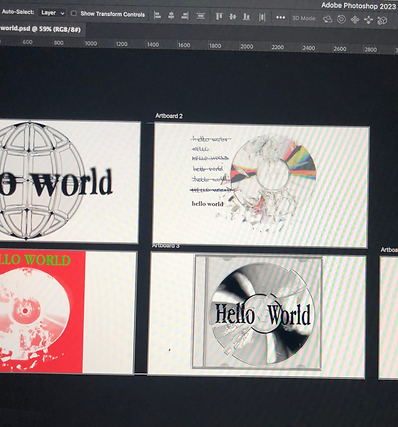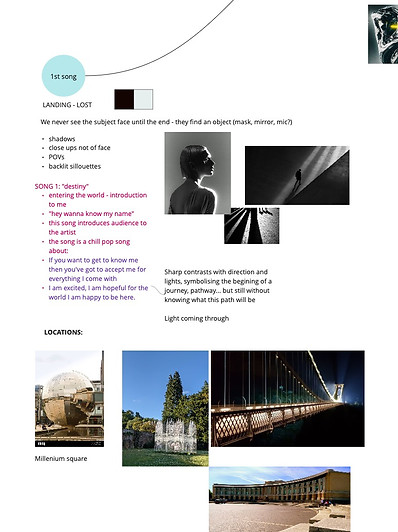'Hello World': Constructing an AI-vocal artist
INNOVATION FINAL YEAR PROJECT
My final year project in Innovation, alongside Ani Mohanamurali, was a practice based exploration of the use and reception of generative AI vocals in music production. We developed our research in tandem with the creation of 'Hello World', a collection of electronic hyper-pop songs produced by Ani using generative AI lead vocals - I was responsible for the song's visual media. With this, we used our practice to prompt research and, at the same time, inform our creative process.
We aimed to provide a practical example for musicians using AI to encourage artists to think critically about the systemic implications they contribute to when releasing AI-assisted music, and provide recommendations and resources to mitigate these.

CHALLENGE:
HOW MIGHT WE CREATE A VIABLE, ETHICAL ARTIST PROPOSAL THAT USES GENERATIVE AI VOCALS?
With the rise of generative AI, Ani and I were curious to explore the creative opportunities of this technology However, there were ethical questions surrounding the use of AI that, as creatives, we still had to get our heads around - we wanted to fully understand the systemic implications of AI and how to mitigate harmful consequences to our creative field.
Similarly, we wanted to understand audiences' reception to music created using AI. Music is home to human emotion and connection for many people, hence we asked ourselves if the emotional relationship between audiences and artists changed when AI was involved, and how to protect this. Sure, AI can create music, but could it be the next Taylor Swift?
OUR PROCESS
To better understand how audiences feel and address the limited available knowledge about reception to AI use in music, we developed a user-centred research approach.
We took on an Agile Process consisting of 3 iterative and reflective sprints, each with a progressive research objective. This allowed us to adapt research to newfound insights and emergent industry developments. Since our methods relied on qualitative data, we took a triangulated approach using mixed methods to ensure the validity of insights.





CREATING THE VISUAL MEDIA
While the music was created using generative AI vocals, the media was mostly shot and all edited by myself and with Ani's creative assistance.
As the person responsible for visual media, my creative direction was also shaped by our research and evolved over time. Initially, we were uncertain about the final form of our proposal, so I created 'proof of concept' visuals—short teasers, 10-second videos, and images—to explore potential directions for 'Hello World', without investing a major time or resources in developing, shooting and editing long video clips. These visuals accompanied the songs and served as research prompts. We found that the relationship between the songs and its visuals strongly influenced audience reception, so these samples helped make our research more comprehensive and allowed us to gather more nuanced insights.
Towards the end of our research, Ani and I mapped out a story-arch to draw a narrative for 'Hello World' - one of feeling lost, trying to hide behind technology, and coming to terms with one's own self. This allowed me to create a mood board for each song and give intention to the art direction.
We aimed for a techy, post-human aesthetic - with mirrors, strobe lights, smoke and blurriness as motifs to evoke a sense of lost identity, ectasy and escapism. We chose RGB, the digital screen primary colours, as our color scheme to fully immerse the footage into the digital realm. Each song was paired with a distinct color to enhance the sense of progression through different stages of a cohesive narrative.
OUTPUT
1. visualiser
Finally, I edited this visualiser with footage that I had been filming throughout research. Our insights, which put more focus into the disclosure of AI from the artist's platforms rather than the music videos themselves, made us take a set back from the visualiser to focus on designing a release campaign. Hence, the visualiser imitates the looping videos that appear on Spotify visuals as a proof of concept of how a larger music video would look like.
2. release campaign & recommendations
As our final output, we created a transparent audience-centred release campaign for ‘Hello World’ as a practical example of how to incorporate our set of recommendations for musicians using AI. The release campaign signifies the crucial first channel of communication where the artist can explain their use of AI vocals to avoid backlash and deception and maintain credibility. These are included in our Final Report, which describes in more detail our project, research, insights and output.
